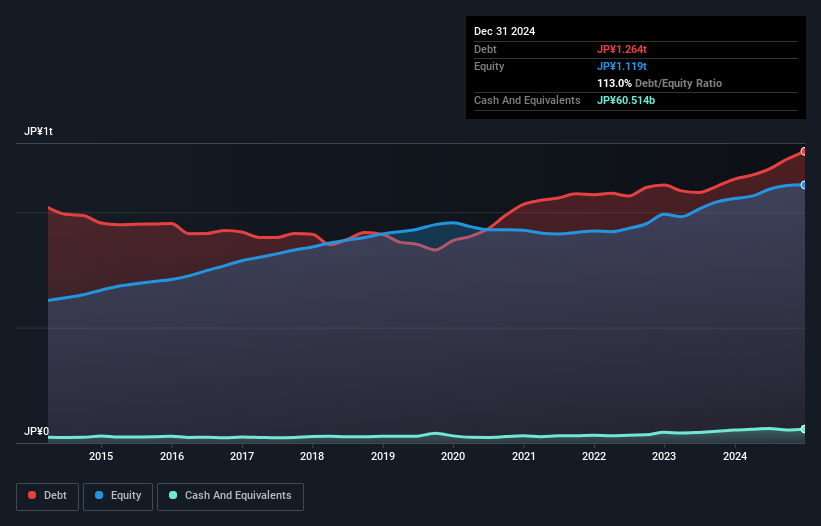David Iben put it well when he said, 'Volatility is not a risk we care about. What we care about is avoiding the permanent loss of capital.' So it might be obvious that you need to consider debt, when you think about how risky any given stock is, because too much debt can sink a company. Importantly, Hankyu Hanshin Holdings, Inc. (TSE:9042) does carry debt. But the real question is whether this debt is making the company risky.
What Risk Does Debt Bring?
Debt assists a business until the business has trouble paying it off, either with new capital or with free cash flow. Ultimately, if the company can't fulfill its legal obligations to repay debt, shareholders could walk away with nothing. However, a more frequent (but still costly) occurrence is where a company must issue shares at bargain-basement prices, permanently diluting shareholders, just to shore up its balance sheet. Of course, debt can be an important tool in businesses, particularly capital heavy businesses. The first thing to do when considering how much debt a business uses is to look at its cash and debt together.
Check out our latest analysis for Hankyu Hanshin Holdings
How Much Debt Does Hankyu Hanshin Holdings Carry?
The image below, which you can click on for greater detail, shows that at December 2024 Hankyu Hanshin Holdings had debt of JP¥1.26t, up from JP¥1.14t in one year. However, it also had JP¥60.5b in cash, and so its net debt is JP¥1.20t.

How Healthy Is Hankyu Hanshin Holdings' Balance Sheet?
The latest balance sheet data shows that Hankyu Hanshin Holdings had liabilities of JP¥481.2b due within a year, and liabilities of JP¥1.56t falling due after that. Offsetting these obligations, it had cash of JP¥60.5b as well as receivables valued at JP¥88.0b due within 12 months. So its liabilities outweigh the sum of its cash and (near-term) receivables by JP¥1.89t.
The deficiency here weighs heavily on the JP¥903.7b company itself, as if a child were struggling under the weight of an enormous back-pack full of books, his sports gear, and a trumpet. So we definitely think shareholders need to watch this one closely. After all, Hankyu Hanshin Holdings would likely require a major re-capitalisation if it had to pay its creditors today.
In order to size up a company's debt relative to its earnings, we calculate its net debt divided by its earnings before interest, tax, depreciation, and amortization (EBITDA) and its earnings before interest and tax (EBIT) divided by its interest expense (its interest cover). The advantage of this approach is that we take into account both the absolute quantum of debt (with net debt to EBITDA) and the actual interest expenses associated with that debt (with its interest cover ratio).
Strangely Hankyu Hanshin Holdings has a sky high EBITDA ratio of 6.9, implying high debt, but a strong interest coverage of 11.6. This means that unless the company has access to very cheap debt, that interest expense will likely grow in the future. Hankyu Hanshin Holdings grew its EBIT by 2.3% in the last year. That's far from incredible but it is a good thing, when it comes to paying off debt. There's no doubt that we learn most about debt from the balance sheet. But ultimately the future profitability of the business will decide if Hankyu Hanshin Holdings can strengthen its balance sheet over time. So if you're focused on the future you can check out this free report showing analyst profit forecasts.
Finally, a company can only pay off debt with cold hard cash, not accounting profits. So it's worth checking how much of that EBIT is backed by free cash flow. Considering the last three years, Hankyu Hanshin Holdings actually recorded a cash outflow, overall. Debt is far more risky for companies with unreliable free cash flow, so shareholders should be hoping that the past expenditure will produce free cash flow in the future.
Our View
To be frank both Hankyu Hanshin Holdings's net debt to EBITDA and its track record of staying on top of its total liabilities make us rather uncomfortable with its debt levels. But at least it's pretty decent at covering its interest expense with its EBIT; that's encouraging. Overall, it seems to us that Hankyu Hanshin Holdings's balance sheet is really quite a risk to the business. For this reason we're pretty cautious about the stock, and we think shareholders should keep a close eye on its liquidity. When analysing debt levels, the balance sheet is the obvious place to start. However, not all investment risk resides within the balance sheet - far from it. These risks can be hard to spot. Every company has them, and we've spotted 2 warning signs for Hankyu Hanshin Holdings (of which 1 is significant!) you should know about.
When all is said and done, sometimes its easier to focus on companies that don't even need debt. Readers can access a list of growth stocks with zero net debt 100% free, right now.
Valuation is complex, but we're here to simplify it.
Discover if Hankyu Hanshin Holdings might be undervalued or overvalued with our detailed analysis, featuring fair value estimates, potential risks, dividends, insider trades, and its financial condition.
Access Free AnalysisHave feedback on this article? Concerned about the content? Get in touch with us directly. Alternatively, email editorial-team (at) simplywallst.com.
This article by Simply Wall St is general in nature. We provide commentary based on historical data and analyst forecasts only using an unbiased methodology and our articles are not intended to be financial advice. It does not constitute a recommendation to buy or sell any stock, and does not take account of your objectives, or your financial situation. We aim to bring you long-term focused analysis driven by fundamental data. Note that our analysis may not factor in the latest price-sensitive company announcements or qualitative material. Simply Wall St has no position in any stocks mentioned.
About TSE:9042
Hankyu Hanshin Holdings
Operates in the urban transportation, real estate, entertainment, information and communication technology, travel, and international transportation businesses in Japan and internationally.
Average dividend payer with questionable track record.
Market Insights
Community Narratives



